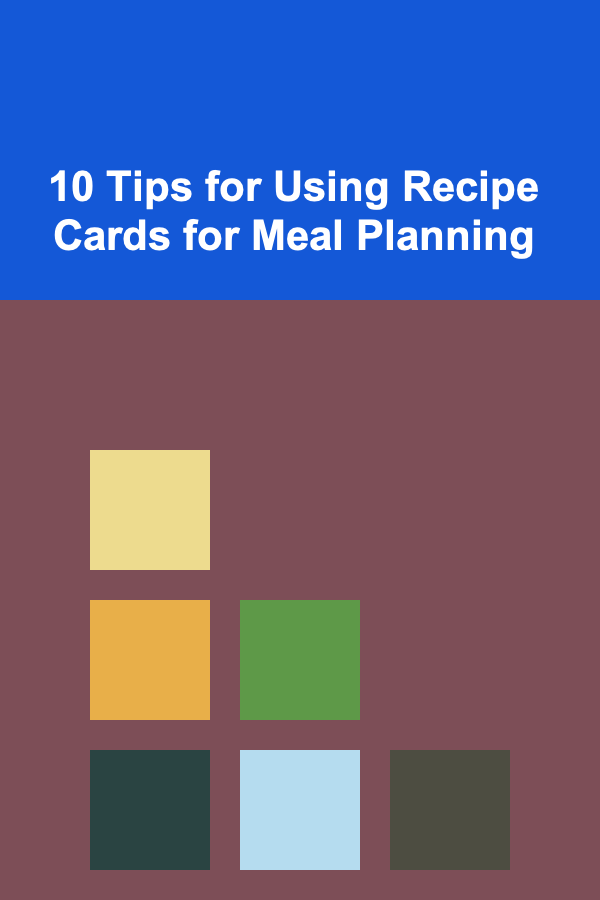
10 Tips for Using Recipe Cards for Meal Planning
ebook include PDF & Audio bundle (Micro Guide)
$12.99$11.99
Limited Time Offer! Order within the next:

Meal planning is a fantastic way to save time, reduce food waste, and make sure you're eating healthy, satisfying meals. While there are many ways to approach meal planning, using recipe cards can be a particularly efficient and enjoyable method. Recipe cards are an organized, customizable tool that can make meal prep more streamlined and convenient.
In this article, we will explore 10 tips for using recipe cards to enhance your meal planning. Whether you are new to meal prepping or an experienced cook, these tips will help you maximize the utility of your recipe cards, making them an essential part of your kitchen.
Create a Recipe Card Binder for Easy Organization
One of the most effective ways to use recipe cards for meal planning is by organizing them in a recipe binder. This allows you to easily access your favorite meals and keeps everything in one place.
How to Organize Your Binder:
- Categorize Your Recipes: Separate your recipe cards into categories such as breakfast, lunch, dinner, snacks, and desserts. You can also have sub-categories like vegetarian, gluten-free, or quick meals.
- Use Dividers: Insert dividers between categories for faster navigation.
- Include Recipe Details: On each card, include key details like cooking time, ingredients, and portion sizes to make meal planning even easier.
This system ensures you always have access to your go-to recipes and allows you to see your options for the week at a glance.
Use Recipe Cards to Plan Your Grocery List
A big part of successful meal planning is having a well-organized grocery list. Recipe cards can make this process more efficient. For each recipe you plan to make, write down the ingredients required on the recipe card. Then, compile the ingredients into a grocery list based on what you have and need to buy.
Benefits:
- Eliminates Duplication: You won't accidentally buy the same ingredients multiple times.
- Streamlines Shopping: Organizing your shopping list by category (produce, dairy, pantry items, etc.) helps you shop more efficiently.
- Reduces Food Waste: By planning your meals around specific recipes, you reduce the chances of purchasing items that you won't use.
With this tip, you'll avoid unnecessary trips to the store and make sure you have all the ingredients you need on hand.
Customize Cards for Meal Prep
Using recipe cards is a great way to stay organized when meal prepping. Meal prep often involves cooking large batches of food to last the week, and recipe cards help you keep track of what needs to be cooked, portioned, and stored.
Customization Tips:
- Write Portion Sizes: Make note of how many servings the recipe will yield so you can plan accordingly.
- Prep Ahead Notes: Include a section on your recipe card that outlines which parts of the recipe can be prepped ahead of time (e.g., chopping vegetables, marinating meat).
- Storage Instructions: If your recipe involves storing food for later, add instructions on how best to store it (e.g., "Freeze for up to 3 months").
This approach ensures you're well-prepared for the week, with meals ready to go when you need them.
Plan for Leftovers
Leftovers are a fantastic way to save time during the week. When you're using recipe cards for meal planning, it's important to think ahead about which meals will provide enough leftovers for the next day or later in the week.
Tips for Leftover Planning:
- Double the Recipe: If a recipe can be doubled, plan to cook extra portions that can be enjoyed later.
- Mark Leftovers on Recipe Cards: On your recipe card, note how long leftovers can be stored in the fridge or freezer, and when you plan to use them.
By planning for leftovers, you can minimize cooking time on busy days while making the most out of the food you prepare.
Add Nutritional Information
If you're mindful of your nutrition or have specific dietary goals, recipe cards can be an excellent way to keep track of calories, macros, or other nutritional information. Add the nutritional details directly onto your recipe card so you can quickly assess whether a dish fits into your dietary plan.
How to Add Nutritional Information:
- Use an App or Website : Tools like MyFitnessPal or nutritiondata.self.com can help you calculate the nutritional value of your recipes.
- Write Key Nutrients: Highlight essential information like calories, protein, fat, and carbs directly on the card.
This strategy will allow you to make more informed meal choices, helping you stay on track with your health goals.
Plan for a Variety of Meals
One of the best things about recipe cards is that they encourage you to get creative with your meal planning. Instead of repeatedly eating the same meals, use your recipe cards to diversify your menu and explore new recipes.
Ideas for Variety:
- Rotate Recipes: If you have a collection of recipes for each meal type (e.g., three breakfast options, five dinner recipes), rotate them each week to keep things fresh.
- Try New Ingredients: Use your recipe cards to experiment with different cuisines or incorporate new ingredients that you've never tried before.
By adding variety to your meal plan, you'll keep mealtime exciting while preventing menu fatigue.
Incorporate Family Preferences
When meal planning, it's essential to consider the preferences of your family or housemates. With recipe cards, you can personalize your meal plan to ensure that everyone is satisfied.
Tips for Family-Friendly Meal Planning:
- Personalized Recipe Cards: Customize your cards by adding notes about individual preferences (e.g., "John loves spicy food" or "Sophie prefers gluten-free meals").
- Family Polls: Create a "family favorites" section in your recipe card binder, where each family member can suggest meals they'd like to see on the menu.
This helps you cater to everyone's tastes and makes meal planning more inclusive.
Keep Track of Seasonal Ingredients
Seasonal ingredients can elevate your meals, providing fresh, locally-sourced options that enhance flavor. Use recipe cards to plan meals that incorporate seasonal fruits, vegetables, and herbs.
How to Track Seasonal Ingredients:
- Create a Seasonal Recipe Section: Add a section to your recipe binder that features recipes based on the current season.
- Note Seasonal Variations: On each recipe card, make note of any seasonal swaps (e.g., use butternut squash in the fall instead of zucchini).
Using seasonal ingredients not only adds variety but also ensures you're making the most of what's fresh and available.
Use Recipe Cards for Special Diets
If you or someone in your family follows a specific diet (e.g., keto, vegan, paleo, etc.), recipe cards can be a valuable tool for keeping track of suitable meals. By organizing recipes based on dietary needs, you can easily plan meals that meet specific guidelines.
How to Organize Special Diets:
- Color-Coding: Use colored cards or labels to differentiate between recipes for specific diets (e.g., blue for keto, green for vegan).
- Diet-Specific Notes: Include diet-specific substitutions and adjustments directly on the recipe cards (e.g., "Use almond flour instead of wheat flour for gluten-free").
This makes meal planning easier and ensures you are always prepared with meals that fit within your dietary restrictions.
Make Recipe Cards Interactive
To take your meal planning to the next level, consider making your recipe cards interactive. This can be especially helpful if you are using digital recipe cards or apps, but even physical cards can be designed to engage you more actively in the process.
Interactive Tips:
- QR Codes: Add QR codes to your recipe cards that link to video tutorials or related recipes.
- Step-by-Step Instructions: Include a small section on each card for step-by-step preparation or cooking tips.
- Notes Section: Leave a space on the card for personal notes, where you can jot down what worked well, changes you made, or variations to try next time.
Interactive cards turn the meal planning process into a more engaging and dynamic experience, encouraging creativity and experimentation in the kitchen.
Conclusion
Recipe cards are an incredibly effective tool for meal planning, offering both practicality and creativity. By organizing your meals, planning your shopping, incorporating nutritional details, and experimenting with new dishes, you can make your meal planning more efficient and enjoyable. Whether you're planning meals for yourself or your entire family, recipe cards can streamline the process and help you stay on top of your kitchen goals.
By following these 10 tips, you'll be able to maximize the potential of your recipe cards and create a meal plan that is both satisfying and sustainable.
Reading More From Our Other Websites
- [Polymer Clay Modeling Tip 101] Secret Tricks to Prevent Cracking and Shrinkage in Polymer Clay Creations
- [Home Holiday Decoration 101] How to Transform Your Bathroom into a Festive Retreat: Holiday Decor for Bathrooms
- [Organization Tip 101] How to Incorporate Seasonal Produce into Your Meal Prep
- [Metal Stamping Tip 101] Best Practices for Maintaining Consistent Sheet Thickness During High‑Volume Stamping
- [Home Renovating 101] How to Renovate Your Home for Increased Energy Efficiency
- [Home Budget Decorating 101] How to Upcycle Furniture into Stylish Pieces Without Breaking the Bank
- [Beachcombing Tip 101] The Best Beaches Worldwide for Amateur Fossil Finders
- [Organization Tip 101] How to Foster a Habit of Daily Tidying in Your Bedroom
- [Organization Tip 101] Essential Tools to Have When Using a Fence Post Repair Kit
- [Personal Investment 101] How to Create and Monetize a Deep Learning-Based SaaS

How to Teach Kids About Money Management at Home
Read More
How to Make Basic Pesto
Read More
How To Brew Your First Batch of Craft Beer at Home
Read More
How to Batch Cook for Easy Weight Loss Meals
Read More
How to Plan a Wedding Videography Timeline
Read More
How to Develop Elite Basketball Court Vision
Read MoreOther Products

How to Teach Kids About Money Management at Home
Read More
How to Make Basic Pesto
Read More
How To Brew Your First Batch of Craft Beer at Home
Read More
How to Batch Cook for Easy Weight Loss Meals
Read More
How to Plan a Wedding Videography Timeline
Read More